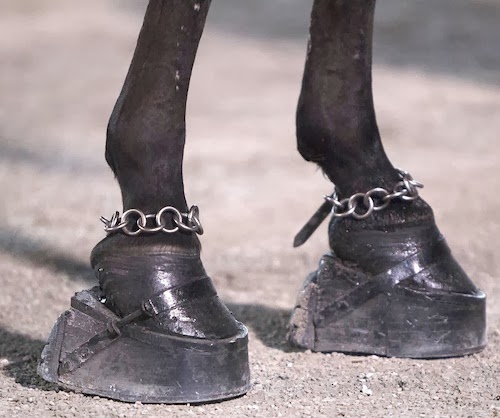The end of August has arrived and that means just one thing: it's time for the Tennessee Walking Horse National Celebration in Shelbyville, Tennessee.
It's one of the largest and possibly most successful horse shows in the United States. As many as 170,000 people from 40 states have attended the 11-day show in recent years. As many as 2,660 horses may compete in the show's171 classes; more than $650,000 in prizes will be awarded.
And if there is a "hot spot" in the horse world for the next two weeks, this show is it. The reason? In spite of more than 30 years on the books, a federal law designed to stamp out the cruel practice of "soring" Tennessee walking horses has failed.
These videos from trainer Winky Groover are posted for educational purposes. Most people have never seen a Tennessee walking horse perform in the show ring, much less on the cross-ties being shod. But everyone does have an opinion.
You should know the process of shoeing a Walking horse and what the different items used are called: packing materials, double-nail pad, hose clamp, chains, etc.
The actual shoeing you see in the video below is not "soring", which would use chemical irritants, short-trimming, and/or sharp objects between the hoof dressing pad and sole of the foot to manipulate the horse's action. Everything you see here is completely "legal" and accepted practice.
The shoeing video simply shows how a stack of pads is attached to the foot and how the foot is prepared for it. In the first video, Winky gives a very general description of the difference between a flat stack and a wedge stack and how trainers adjust or increase the weight and shape of the stack to manipulate lift or reach.
In June of this year the American Association of Equine Practitioners (AAEP) and the American Veterinary Medical Association (AVMA) called for the stacked pads, pastern chains and hose clamps you see in these videos to be banned since they form the basis of the system and can be manipulated to the detriment of the horse. (see link below)
Today we learned that the "DQP" (non-USDA) inspectors at the Celebration plan to swab all the horses' pasterns to detect chemicals. This the latest in a confusing series of events in the past few months, including a lawsuit against the USDA, a de-certification of the Celebration's inspection organization, and the impression that the elimination of soring could simply be postponed indefinitely while lawsuits and countersuits sort themselves out.
But the show must go on, and the Celebration says it is going to swab pasterns and that this is a great move forward.
When used at the 2011 Celebration, swabbing revealed that 50 of 52 samples were positive for foreign substances. Most positives were for numbing agents.
According to a press release from the Celebration, swabbing results will be made public during the event for the first time. Violations will be punished severely, the Celebration says, by suspending trainers’ licenses, disqualifying horses, removing ribbons, trophies and prize money.
Will there be more news from Shelbyville about Walking horses and soring between now and Labor Day? Probably. But at least by watching those two videos you'll know the basics of the horseshoeing part of the equation. The human and legal parts of the equation are much more complicated.
Thanks to the Tennessean newspaper for making these videos available.
Hoofcare Publishing and Fran Jurga do not endorse or recommend the practice of soring. Tennessee walking horses are wonderful animals and deserve the best possible care as well as a speedy solution to this controversy. Techniques shown in these videos are for increased understanding only and are not meant for instruction or to pass judgment.
To learn more:
HSUS anti-soring billboard rises near Celebration showgrounds
AVMA and AAEP call for ban on stacked pads, chains, and clamps
Background article on controversy surround the Celebration's inspections: "Change eyed in walking horse industry"
(Times Free Press)
© Fran Jurga and Hoofcare Publishing; Fran Jurga's Hoof Blog is a between-issues news service for subscribers to Hoofcare and Lameness Journal. Please, no use without permission. You only need to ask. This blog may be read online at the blog page, checked via RSS feed, or received via a digest-type email (requires signup in box at top right of blog page). To subscribe to Hoofcare and Lameness (the journal), please visit the main site, www.hoofcare.com, where many educational products and media related to equine lameness and hoof science can be found. Questions or problems with this blog? Send email to blog@hoofcare.com.
Read this blog's headlines on the Hoofcare + Lameness Facebook Page
Disclosure of Material Connection: I have not received any direct compensation for writing this post. I have no material connection to the brands, products, or services that I have mentioned, other than Hoofcare Publishing. I am disclosing this in accordance with the Federal Trade Commission’s 16 CFR, Part 255: Guides Concerning the Use of Endorsements and Testimonials in Advertising.







